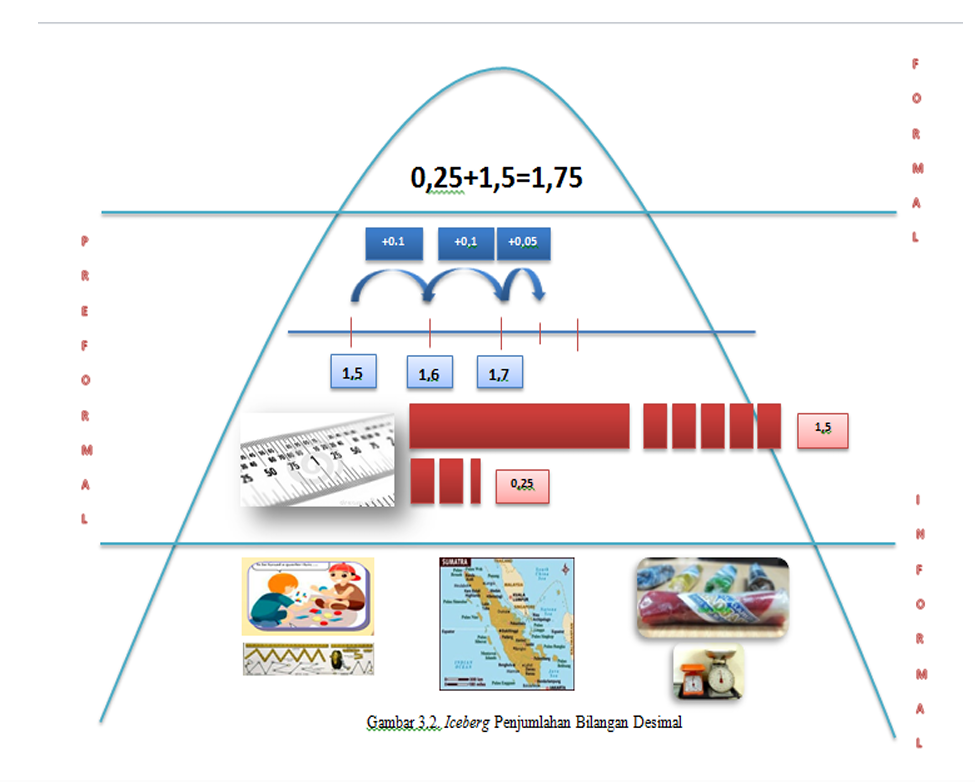Main Article Content
Abstract
Many recent studies found that students tended to have difficulty in grasping the concept of the operation of decimal numbers, especially on addition. In order to overcome all the difficulties, this study presents a sequence of classroom activities constructing the understanding of decimals addition. Realistic Mathematics Education (RME) underlies the design of the context and the activities. Design research was chosen as an appropriate means to achieve the aim. It will be conducted in three phases, preliminary design, teaching experiment (first and second cycle), and retrospective analysis. This study involves 6 students (first cycle) and 34 students (second cycle); 4 students. The result of this study can show that a sequence of activities can bring students’ learning from the contextual situation to more formal situation. Students did not think about integer number system when doing decimal number problem. They could do every contextual problem with their reasoning. Learning trajectory on this study can be used for school learning.
Keywords
Article Details
Copyright (c) 2025 Ekasatya Aldila Afriyansyah, Ratu Ilma Indra Putri

This work is licensed under a Creative Commons Attribution 4.0 International License.
This journal provides immediate open access to its content on the principle that making research freely available to the public supports a greater global exchange of knowledge.
All articles published Open Access will be immediately and permanently free for everyone to read and download. We are continuously working with our author communities to select the best choice of license options, Creative Commons Attribution-ShareAlike (CC BY-NC-SA).
References
- Bakker, A. (2004). Design Research in Statistics Education. On Symbolizing and Computer Tools. Amersfoort: Wilco Press.
- Gravemeijer. K. (1994). Developing Realistic Mathematics Education. Utrecht: Freudenthal Institute.
- Gravemeijer, K. (1999). How emergent models may foster the constitution of formal mathematics. Mathematical Thinking and Learning, 1(2), 155-177.
- Gravemeijer, K. and Cobb, P. (2006). Design research from the learning design perspective, Educational design research, 17-51, London: Routladge.
- Irwin, K. C. (2001). Difficulties with decimals and using everyday contexts to overcome them, Journal for Research in Mathematics Education, 32, 399-421.
- Moody, B. (2008). Connecting the Points: An investigation into student learning about decimal numbers, New Zealand: Waikato University.
- Pramudiani, P. (2011). Students’ learning of comparing the magnitude of one-digit and two-digit decimals using number line. A Design Research on Decimals at Grade 5 in Indonesian Primary School, Sriwijaya University-Utrecht University.
- Price, P. S. (2001). The Development of Year 3 Students’ Place-Value Understanding: Representations and Concepts. Queensland University of Technology.
- Ubuz, B., and Yayan, B. (2010). Primary teachers’ subject matter knowledge: Decimals. International Journal of Mathematical Education in Science and Technology, 41(6), 787-804, 201.
- Van Galen, F. V., Figuerido, N., and Keijzer, R. (2008). Fractions, Percentages, Decimals, and Proportions, Freudenthal Institute: Sense Publishers.
- Widjaja, W. (2008). Local Instruction Theory on Decimals: The Case of Indonesian Pre- Service Teachers. Australia: university of Melbourne.
- Zulkardi. (2002). Developing A Learning Environment on Realistic Mathematics Education For Indonesian Student Teachers. Enschede: Twente University.
References
Bakker, A. (2004). Design Research in Statistics Education. On Symbolizing and Computer Tools. Amersfoort: Wilco Press.
Gravemeijer. K. (1994). Developing Realistic Mathematics Education. Utrecht: Freudenthal Institute.
Gravemeijer, K. (1999). How emergent models may foster the constitution of formal mathematics. Mathematical Thinking and Learning, 1(2), 155-177.
Gravemeijer, K. and Cobb, P. (2006). Design research from the learning design perspective, Educational design research, 17-51, London: Routladge.
Irwin, K. C. (2001). Difficulties with decimals and using everyday contexts to overcome them, Journal for Research in Mathematics Education, 32, 399-421.
Moody, B. (2008). Connecting the Points: An investigation into student learning about decimal numbers, New Zealand: Waikato University.
Pramudiani, P. (2011). Students’ learning of comparing the magnitude of one-digit and two-digit decimals using number line. A Design Research on Decimals at Grade 5 in Indonesian Primary School, Sriwijaya University-Utrecht University.
Price, P. S. (2001). The Development of Year 3 Students’ Place-Value Understanding: Representations and Concepts. Queensland University of Technology.
Ubuz, B., and Yayan, B. (2010). Primary teachers’ subject matter knowledge: Decimals. International Journal of Mathematical Education in Science and Technology, 41(6), 787-804, 201.
Van Galen, F. V., Figuerido, N., and Keijzer, R. (2008). Fractions, Percentages, Decimals, and Proportions, Freudenthal Institute: Sense Publishers.
Widjaja, W. (2008). Local Instruction Theory on Decimals: The Case of Indonesian Pre- Service Teachers. Australia: university of Melbourne.
Zulkardi. (2002). Developing A Learning Environment on Realistic Mathematics Education For Indonesian Student Teachers. Enschede: Twente University.

